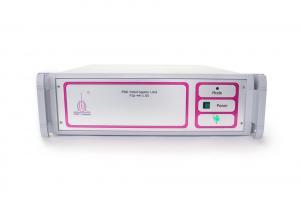For diagnostics and monitoring
Interrogation monitor (FBG)
FBG interrogation monitor for process control and registration of optical signals from the sensors
The FBG interrogation unit FIU – 44 – 1.55 up to 4 kHz provides registration of optical signals from unified sensor heads based on Fiber Bragg Gratings (FBGs) with a sampling frequency up to 4 kHz per second for one channel.
A distinctive feature of FIU for process control is the ability to interrogate the entire complex of fiber sensors with a sampling frequency of 400Hz.
Data processing and visualization can be performed either by the built-in computer with specialized software or be transmitted via the Modbus protocol to the user system

Measurable physical quantities:
By using various sensor head types, an FIU-based flexible multipurpose telemetry system can be constructed. Multipoint, quasi-distributed, or point simultaneous measurements can be implemented with such a system, the measurable physical quantities being as follows:
Technical characteristics
PARAMETER / ARTICLE |
FIU-44-1.55-40-S-А4-IP40* |
FIU-44-1.55-40-Er-A4-IP40* |
| Spectral width of an optical channel, nm | 1510 ÷ 1595 | 1525 ÷ 1595 |
| Polarization state of the light source | partially polarized | depolarized |
| The number of optical channels | 1 – 8 | |
| The number of sensors per channel | 16 | |
| Range of intensities of the registered optical signals, dBm | -80 ÷ -20 | |
| Dynamic range, dB | 25 | |
| Total optical power light source, dBm*** | 0 | |
| Sampling frequency for one channel, kHz | < 4 | |
| Processing time and outputting data of one channel, sec | < 0,05 | |
| Software | The FBG interrogator is equipped with a built-in fully functional software URM_Control | |
| Output interfaces | USB 2.0, USB 3.0, Ethernet RJ45, SVGA, DVI-I, HDMI | |
| Power consumption, W | < 250 | |
| Protection class IEC 60529 | IP40 | |
| Working temperature range, ºС | +10 ÷ +40 | |
| Humidity, % (no condensation) | < 80 | |
| Power supply, V/Hz | 220/50 | |
* – the S-series of the FBG interrogation units have the partial polarization of the output radiation. As result it has greater measurement error when using fiber optic sensors.
** – sensor which consists of a single Bragg grating (FBG).
*** – on the request, up to 10dBm.
Advantages of the fiber-optic sensors:
- high sensitivity and speed;
- high immunity to noises and electromagnetic interferences, such as microwave and magnetic fields, spark discharge, and electromagnetic pulses of any nature and any intensity;
- full electrical safety, which is due to the absence of electric circuits between the sensor and the registration module;
- full explosion and fire safety, high chemical resistance of the sensing elements;
Areas of application:
- energy production, including nuclear and thermonuclear installations;
- aviation and cosmonautics;
- land, water and underwater transport;
- metallurgy and chemical industry;
- oil and gas production;
- pipeline transport;
- construction;
- medicine;
- security systems;
- scientific research.
![]() FBG interrogation monitor for process control and registration of optical signals from the sensors
FBG interrogation monitor for process control and registration of optical signals from the sensors
